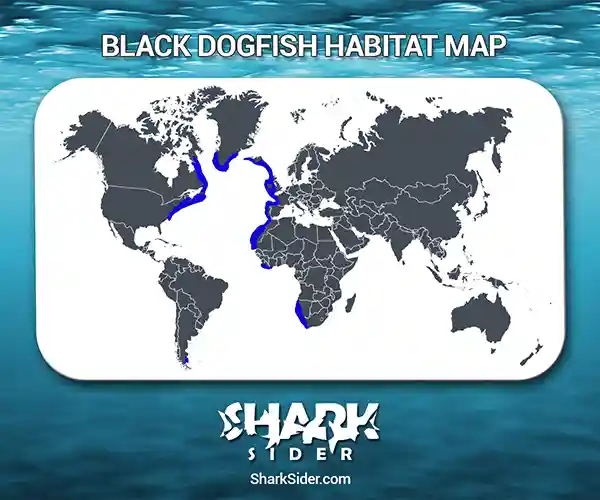The largest member of its family Etmopteridae, the black dogfish is a small species of dogfish shark that dwells in deep waters.
Johannes Reinhardt, a Danish zoologist described the species in his work titled – ‘Ichthyological Contributions’ published in 1825. His research was based on a specimen collected off Julianehåb in Greenland. Reinhardt named the species in honor of naturalist Otto Fabricius, a missionary known for being a pioneer in the study of Greenlandic fishes.
Black Dogfish Scientific Classification |
|
| Kingdom | Animalia |
| Phylum | Chordata |
| Class | Chondrichthyes |
| Order | Squaliformes |
| Family | Etmopteridae |
| Genus | Centroscyllium |
| Scientific Name | Centroscyllium fabricii |
Description
The adults of these species have been known to measure 24-30 inches in length and can grow up to 3.6 ft.
Females end up being bigger than males. Grown adults and sub-adults of this species have a uniform black body color. Juveniles have a dark black upper body and a lighter black-brown underside with the dorsal, pectoral, and pelvic fins with a white edge. All sizes of the black dogfish have tiny, luminescent dots scattered about their skin in an irregular pattern.
They have a unique appearance, are bulky overall, and flattened towards the sides.
Their head consists of a long, thick, and broadly arched snout and horizontally oval eyes emitting a reflective green light. Right behind them are small spiracles with accessory respiratory openings. Short flaps of skin cover their anterior placed nostrils. These sharks have giant mouths with thin lips and the presence of deep furrows at the corners. Both jaws contain 34 tooth rows on either side, with each tooth consisting of 3-5 slender cusps, with the middle cusp being the longest.
Their second fin originates over the mid-pelvic baseline and is larger than the first dorsal fin. There is the presence of prominent-looking, grooved spines in both of their dorsal fins. The pectoral fins are close to their body surface and almost reach the origin of the first dorsal fin. Anal fins are absent in these sharks.
Where do they live
Map Of The Black Dogfish Shark’s Habitat

These dogfishes are a common species distributed in the Atlantic Ocean. Its has a wide range occupying parts of the northeast Atlantic Ocean (the Faroe Islands, southern Norway, and the Rockall Trough and Porcupine Seabight), the northwest Atlantic Ocean (southern Greenland and Baffin Island to Virginia, the Laurentian Channel, southwards to the Gulf of Mexico off Alabama), the southeast Atlantic Ocean (Namibia, as far as Cape Agulhas in South Africa), and the southwest (Beagle Channel present in Argentina’s southern point).
These sharks are found near the bottom at depths varying with their geographical distribution on continental slopes and shelves. They dwell at 2600-3900ft in Iceland, 4,100–4,920 ft in the Rockall Trough, 1,600–4,300 ft off the waters of Greenland, 1,150–1,640 ft off the shore of northern Canada, and below 1600 ft in the coastal waters of southern Africa.
During the winter months, these sharks have been known to swim closer to the surface.
They prefer water temperatures of38.3-40.1 °F and can tolerate temperatures up to 34 °F. Offshore in northern Canada, the sharks are common in temperatures of 41.0–43.7 °F.
Behavior
Social
They mostly form schools or shoals that become larger during spring and winter, dwelling in the shallower waters. These sharks are active yet do not display increased bursts of speed, unlike other spiny dogfishes living in shallow waters.
Dietary
They are versatile and opportunistic in feeding and scavenging on whatever food is available. These sharks hunt in open water and even reach the ocean bottom for food. Most of its diet consists of bony fishes like rattails, whitings, rockfishes, lanternfishes, and barracudinas, as well as pelagic and benthic crustaceans such as shrimp and krill, and some cephalopods. They also consume polychaete worms and jellyfish.
The refuse of the Greenland halibut, and rattails discarded from fishing vessels, have become a significant source of food, particularly for older sharks living around the northwestern Atlantic Ocean.
Reproductory
These dogfish sharks follow an ovoviviparous reproduction pattern (young come out after hatching directly from the eggs inside the mother’s body). The developing embryos depend entirely on the egg yolk reserves for sustenance.
There are no fixed reproduction seasonal patterns in these sharks. A pair of two functional ovaries and uterus is present in mature females. Eggs inside the uterus are not enclosed in a capsule and have a 1.2-1.8 inches diameter.
Newborns in a litter are present in numbers of 4-40, each measuring 5.1-7.5 inches.
Males of this species reach the stage of sexual maturity between lengths of 18-25 inches, whereas females mature at body lengths of 20-28 inches.
Adaptations
The organs in the dots in the sharks’ skin give them bioluminescence properties. This adaptation helps them swim in dark regions like underwater caves. The sharks may also take advantage of their bioluminescence, using it as camouflage while fleeing away from predators.
Interactions with humans
There have been no reports of this shark attacking humans as it is harmless. They’re of little commercial value but are sometimes caught by deep-sea trawlers, gillnets, or long-line fisheries which catch commercial fishes in the North Atlantic Ocean.
If caught accidentally, these sharks are usually used as fish bait in European countries like France instead of throwing them back into the ocean.
The IUCN has listed the black dogfish as a species of ‘Least Concern’ worldwide. These deep-water, bottom-dwelling fishes are rarely caught during commercial fishing. This has lessened the threat of their survival or population depletion. In the northeast Atlantic, where it has been assessed as Near Threatened, catching this species is monitored by the International Council for the Exploration of the Sea (ICES), which allows a certain amount to be caught annually.
